Kyoto, once Japan’s capital for over a thousand years, is located in the Kansai region. It’s famous for its well-preserved temples, traditional tea houses, and the geisha district of Gion. Kyoto is the perfect destination for those seeking an authentic Japanese experience and five days in Kyoto are ideal to cover the highlights, main attractions, and traditional activities, plus a day trip to Nara.
As I learned during my trip to Kyoto, having a planned itinerary ensures you don’t miss out on the best parts. This guide will outline a well-thought-out 5-day itinerary for Kyoto, which includes must-see attractions as well as some lesser-known spots perfect for quiet exploration.
Table of Contents
- A few tips for Kyoto
- Day 1: Higashiyama
- Yasaka Shrine
- Maruyama Park
- Chion-in
- Shijo Dori
- Gion District
- Kaiseki Dinner
- Day 2: Arashiyama
- Tenryu-ji Temple
- Arashiyama Bamboo Forest
- Okochi Sanso Villa
- Jōjakukō-ji Temple
- Gio-ji Temple
- Saga-Toriimoto Preserved Street
- Lunch at Ayu-no-Yado Tsutaya
- Adashino-Nembutsu-ji Temple
- Otagi Nenbutsu-ji
- Day 3: Downtown and Fushimi Inari
- Kimono & Tea Ceremony
- Nishiki market
- Nijō Castle
- Fushimi Inari Taisha
- Day 4: Philosopher Path & Kinkaku-ji
- Kiyomizu-dera
- Nanzen-ji Temple
- Philosopher’s Path
- Jisho-ji (Ginkakuji)
- Kinkaku-ji
- Day 5: Day trip to Nara
- Nara Park
- Todai-ji Temple
- Kasuga-taisha Shrine
- Naramachi
- Uji
- Accommodation in Kyoto
- More tips for Kyoto
- Frequently Asked Questions
A few tips for Kyoto
Kyoto is quite walkable, especially in areas concentrated with cultural sites like Higashiyama. Many of Kyoto’s attractions are located close to each other within these historic districts, making walking a pleasant and efficient way to see the city. However, Kyoto also spreads out to areas like Arashiyama in the west and the Fushimi Inari Shrine in the southeast, which are best accessed by public transport.
Speaking of public transport, unlike Tokyo, Kyoto relies a lot more on buses. To save time and money, get a Kansai Thru Pass to access all the public transport during your visit, without having to buy individual tickets.
Kyoto’s streets can be confusing, as the city layout is like a grid. Travel Apps like Google Maps are incredibly helpful for navigating.
Kyoto gets quite crowded, especially during the cherry blossom season. However, nobody particularly rushes around, so you will still have a relaxing time visiting Kyoto. You just need to take it easy and wait for your turn patiently.
Most temples and shrines in Kyoto accept cash only. The same goes for most street food vendors.
Kyoto is very traditional, and many residents take great pride in their unique manners and etiquette. I wrote a whole book teaching you how to behave in Japan.
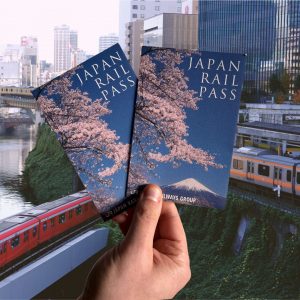
Japan Rail Pass
The optimal way to explore Japan is with a rail pass that is available for durations of 7, 14, or 21 days, offering unlimited travel across the country. Shinkansen included!
Day 1: Higashiyama
Higashiyama is arguably the most beautiful part of Kyoto, with its traditional Gion District, shrines, temples and the stunning Maruyama park. When you visit Kyoto for the first time, chances are you want to make sure you see Gion on day one. Since Gion is most beautiful in the evening, I made sure to timed it just right for you.
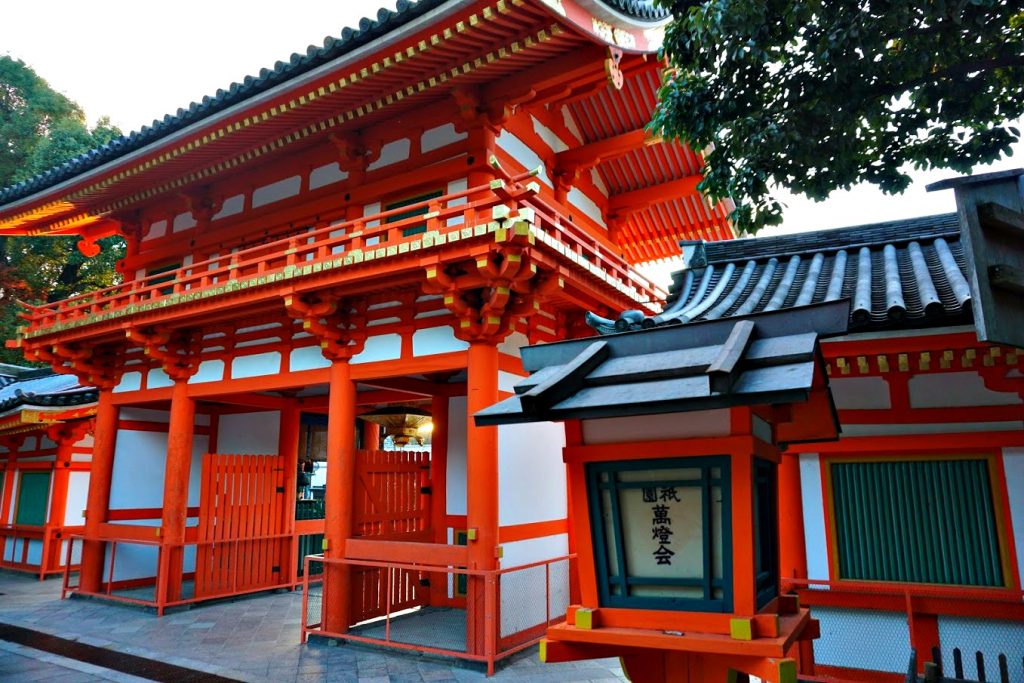
Yasaka Shrine
Start the day with a visit to the stunning Yasaka Shrine. Once called the Gion Shrine, Yasaka is a beautiful Shinto Shrine built in 656. It was originally built to protect the city from pandemics. Nowadays, Yasaka Shrine hosts one of Japan’s most loved festivals, Gion Matsuri held in July.
It’s common to see street food stalls at Yasaka Shrine.
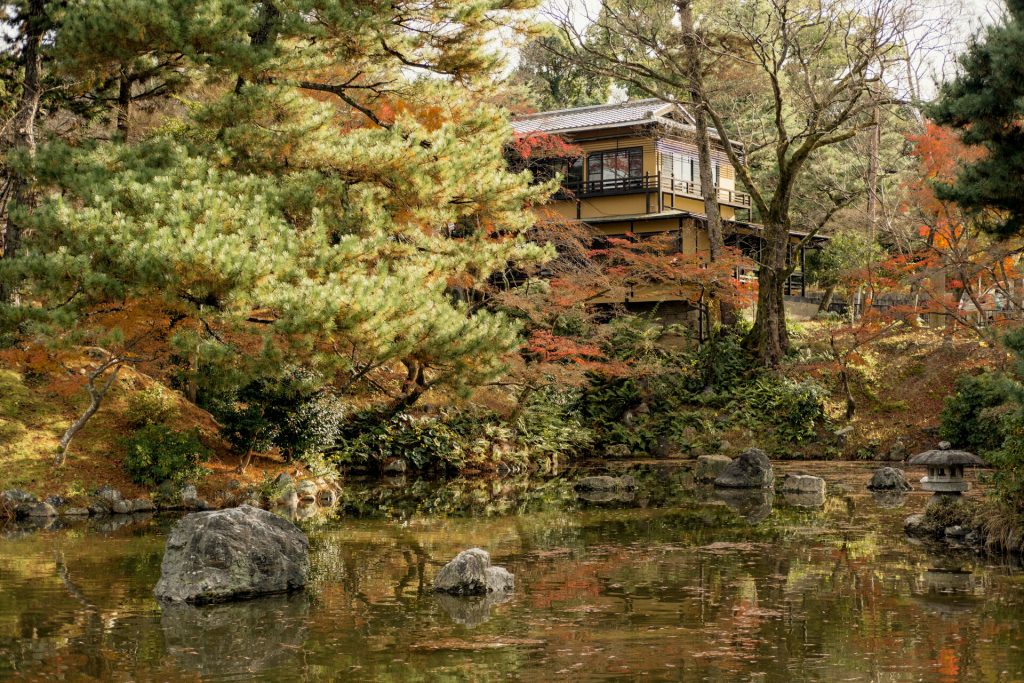
Maruyama Park
Maruyama Park is adjacent to Yasaka Shrine, and it’s the city’s oldest public park. Many come here to see the cherry blossoms, but the most notable point of interest is a large weeping cherry tree which is 90 years old and 12 meters tall.
During festivals and on national holidays, Maruyama Park features pop-up food stalls offering snacks and drinks. Personally, I find the park most stunning in autumn, when the many Japanese maple trees transform into a gorgeous display of reds and oranges.
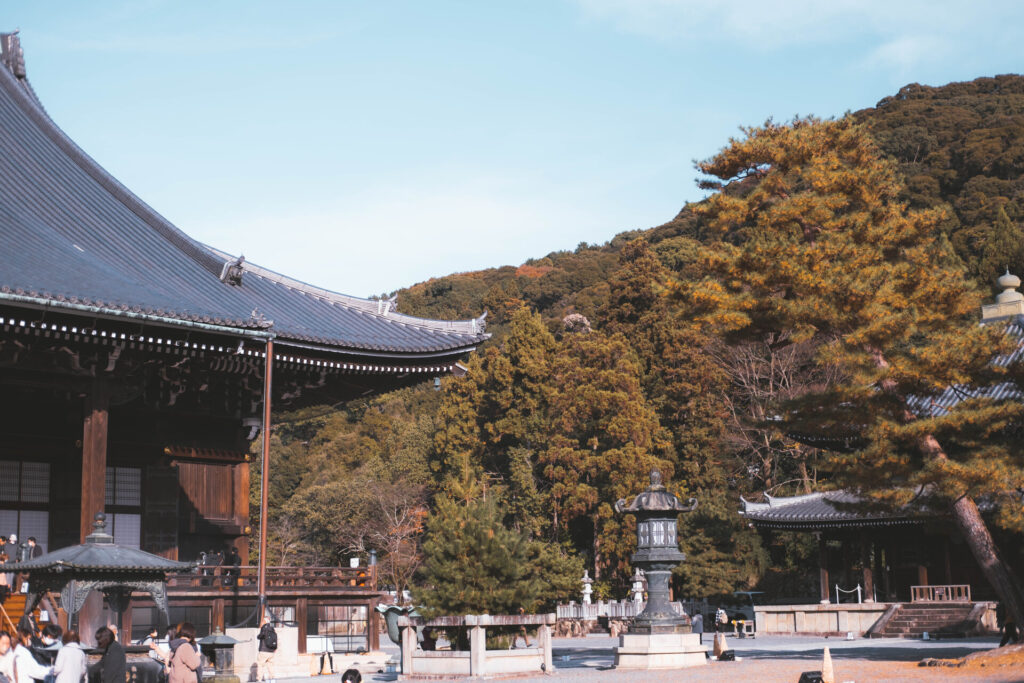
Chion-in
Chion-in Temple, located right behind Maruyama Park, is a key Buddhist site and the headquarters of the Jodo sect. It’s famous for its huge Sanmon gate, one of the biggest in Japan. The temple was started in the 13th century by Honen, who started Pure Land Buddhism.
There’s also a less-known spot there called Yuzen-en garden. It’s named after the Yuzen dyeing method and is a quiet place that many tourists don’t know about.
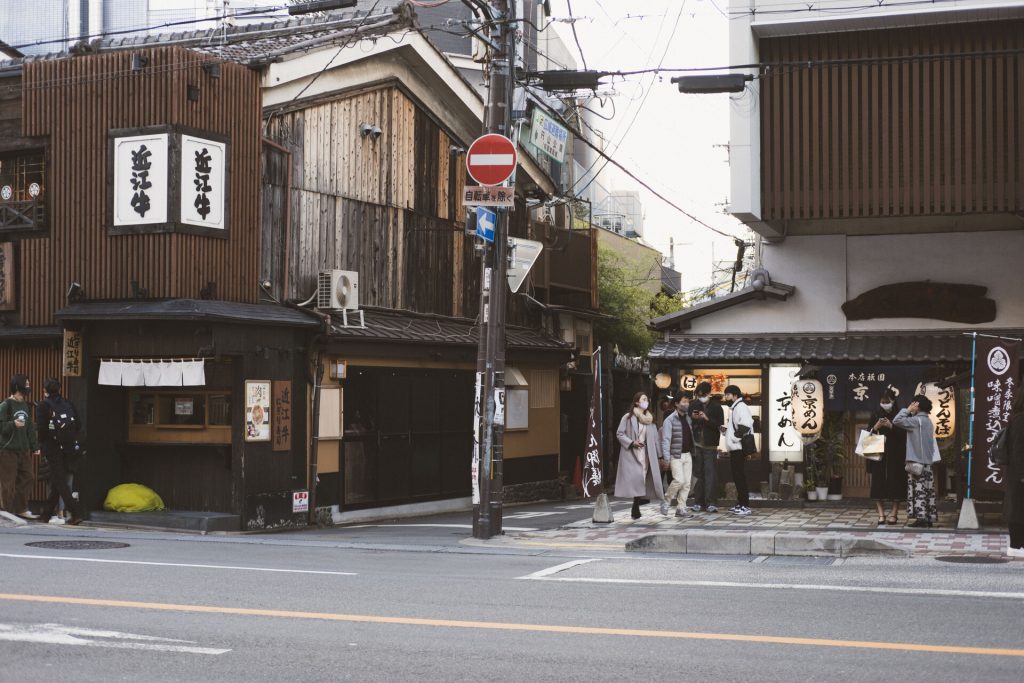
Shijo Dori
Your next stop is Shijo Dori. It’s the go-to spot for indulging in sweets, tea, ice cream, mochi, and dango. Despite being crowded with tourists, the wait is definitely worth it for the fantastic food.
Take your time to wander from shop to shop, taste the various offerings, and pick whatever catches your fancy. You might find yourself spending a few hours exploring this area. My husband and I liked it so much that we went back twice during our Kyoto visit to fully enjoy everything it had to offer.
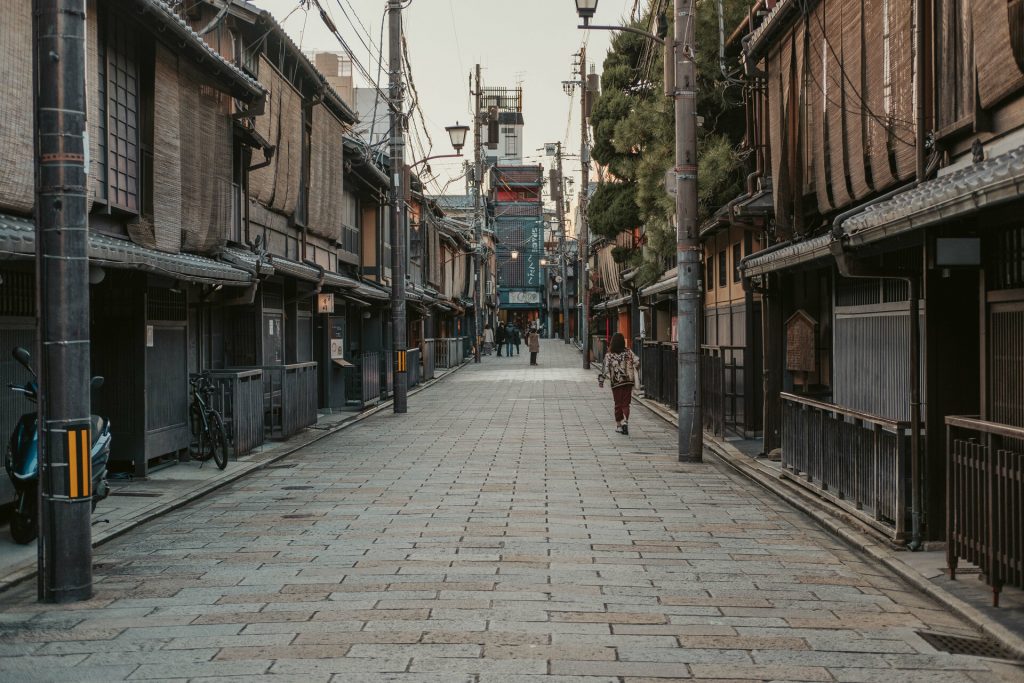
Gion District
Gion stands out as one of Kyoto’s iconic areas, celebrated for its traditional wooden machiya houses, teahouses, and being the center of geisha culture in the city.
It’s known for being one of Kyoto’s most picturesque and well-kept districts. Visitors from around the globe flock to Gion, drawn not only by its stunning architecture, but also by the chance to catch a glimpse of the elusive geishas. Gion has a history that dates back over a thousand years.
Hanamikoji Dori is the most popular and visited street in Gion. It stretches from Shijo-dori in the north to Kennin-ji Temple at its southern end.
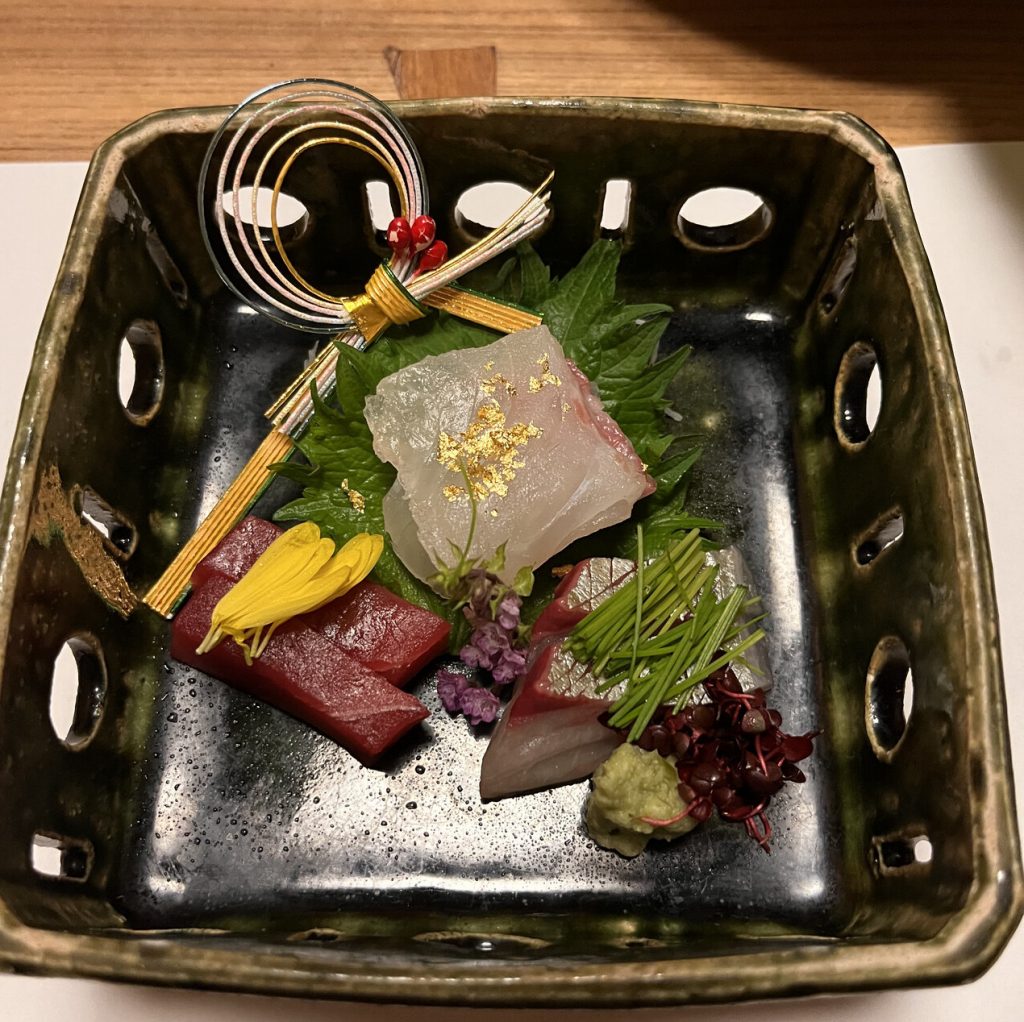
Kaiseki Dinner
End your first day in Kyoto with an exquisite kaiseki dinner. Kaiseki is a traditional Japanese multi course meal which consists of several small dishes so you can try various textures and seasonal foods.
In Kyoto, the best place for Kaiseki is in the Higashiyama district. Note that you will most likely need to reserve your spot, as most kaiseki dinners are reserved a few days in advance.
There are two kaiseki spots I especially recommend in Higashiyama:
Hanasaki Manjiro – Hanasaki manjiro was by far our favorite kaiseki restaurant in Kyoto. We continue to recommend it to everyone who visits Kyoto. Book a table via the official Hanasaki Manjiro website.
Kiyamachi tousuiro – Multi-course tofu meals served in a traditional Japanese house. There are counter seats as well as low tables on tatami. Book a table via the official Kiyamachi tousuiro website.
Day 2: Arashiyama
Arashiyama is a district located on the western outskirts of Kyoto. It’s mainly known for the Arashiyama Bamboo Forest, but the area has many gorgeous temples and even a superb, well-preserved street in the mountains. Many temples have viewing platforms which offer some of the most gorgeous views over the Storm Mountains and Kyoto city.
The best time to visit the Arashiyama Bamboo Forest is first thing in the morning to avoid the most tourist crowds. Just note that most shops do open at around 9am.
Tenryu-ji Temple
The first stop of the day is the Tenryu-ji Temple, located just a few minutes walk from the Arashiyama station. Tenryu-ji Temple dates back to the 14th century, and it is one of the key highlights in Arashiyama. It is known for its stunning Zen garden, Sōgenchi Teien, and its traditional tea house.
Tenryu-ji Temple is recognized as a UNESCO World Heritage Site under the “Historic Monuments of Ancient Kyoto” category.
The temple also features a pond garden, which has been officially marked as a Special Place of Scenic Beauty in Japan.
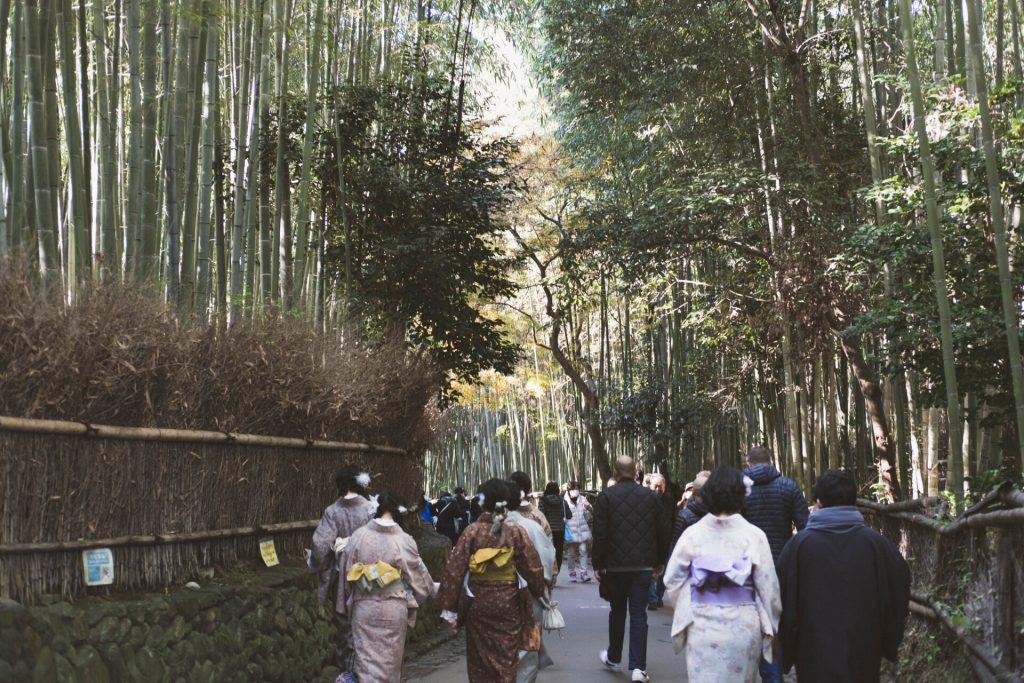
Arashiyama Bamboo Forest
Next, walk through the Arashiyama Bamboo Forest, which is a well-defined walking path lined with tall and thick bamboo stalks. This bamboo grove is unique thanks to the tall stalks form a natural cathedral above you. The height of the bamboo means that the leaves at the top softly filter sunlight, bathing the path in a gentle, dreamlike light
Good to know: There is an adjacent path created exclusively for rickshaws. If you want to see the bamboo forest without the crowds, book a rickshaw tour.
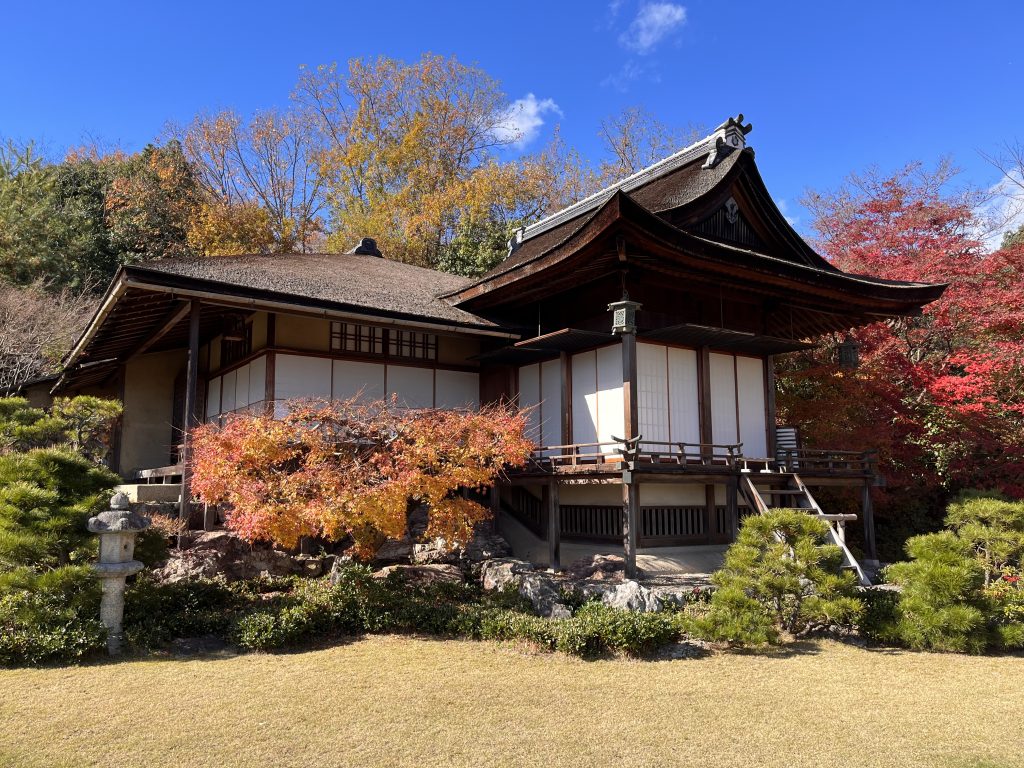
Okochi Sanso Villa
Okochi-Sanso Villa was the home of Denjirō Ōkōchi, a famous film actor, and has been featured in numerous movies. The highlight of this villa is its magnificent garden, designed with a clear path guiding visitors through its main attractions.There are spots offering breathtaking views of the forested Arashiyama mountains and the rooftops of Kyoto.
Though the entrance fee may seem high, it includes a freshly prepared bowl of matcha tea and a small wagashi (Japanese sweet), adding value to the experience.
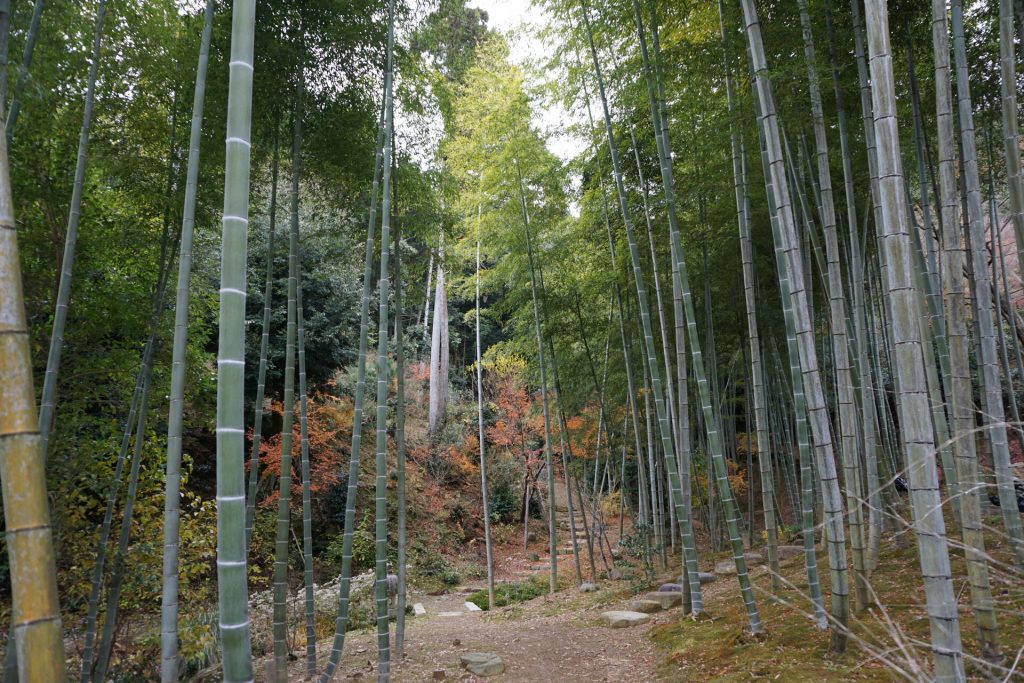
Jōjakukō-ji Temple
Jōjakkōji Temple, established in 1596, is nestled on the slopes of Mount Ogura and is celebrated for its stunning mountain vistas. This temple is adorned with a picturesque pagoda, verdant moss gardens, and an abundance of maple trees that blaze in brilliant reds and oranges during koyo. Be prepared to ascend some stone steps to reach these breathtaking views.
And here’s a little secret just between us: the temple also has a small, hidden bamboo grove.
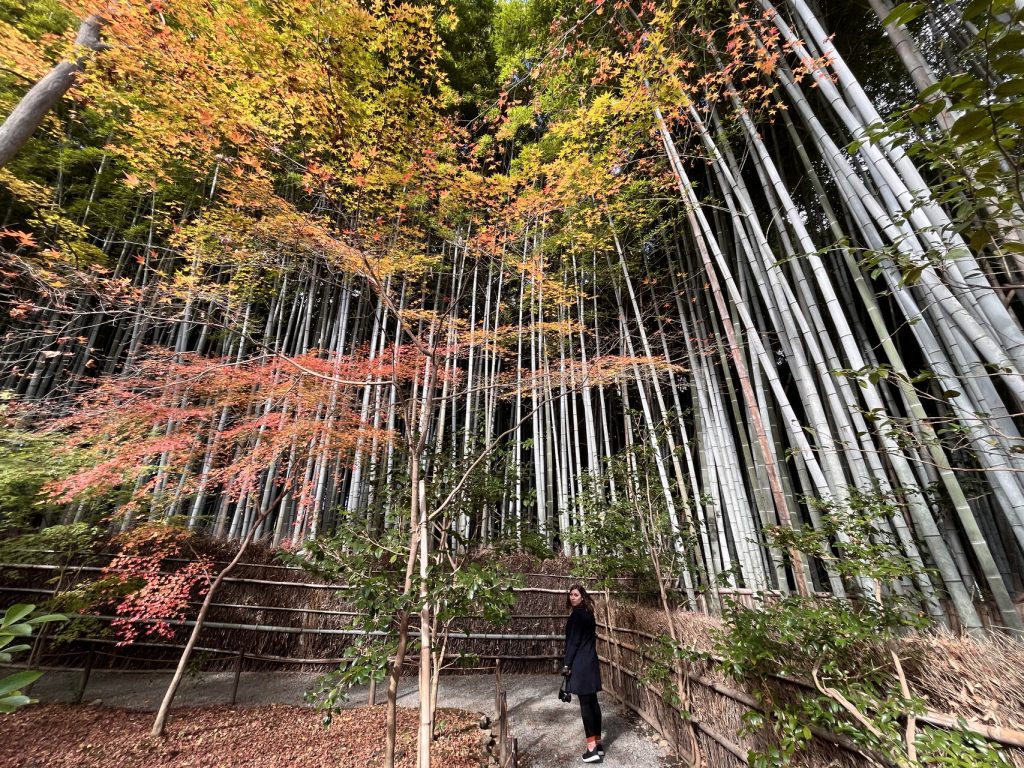
Gio-ji Temple
Gio-ji Temple is a hidden gem, not as widely visited as others. It’s a must-see for its enchanting moss garden, and, like Jōjakkōji, it also features a small bamboo grove.
Named after Gio, a Heian period dancer who turned to a monastic life following heartbreak, Gio-ji served as her sanctuary. Sure, it may be a small temple, but the garden is so beautiful and well worth a visit.
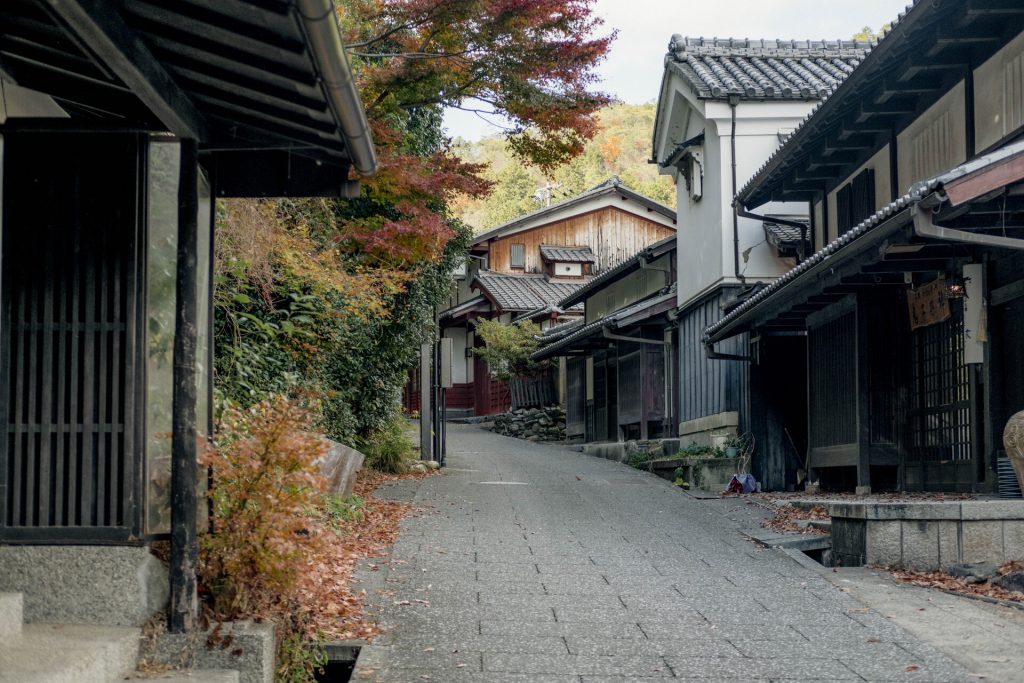
Saga-Toriimoto Preserved Street
Saga Toriimoto Preserved Street captures the essence of the late Edo Period with its narrow alleyway lined with traditional wooden houses now repurposed into quaint shops.
Not many people venture as far as Saga-Toriimoto Preserved Street from Arashiyama Bamboo Grove, so it’s a fairly quiet spot, away from the crowds. There are a few unique shops here, including the Adashino Mayumura which specializes in crafting dolls from silk cocoons.
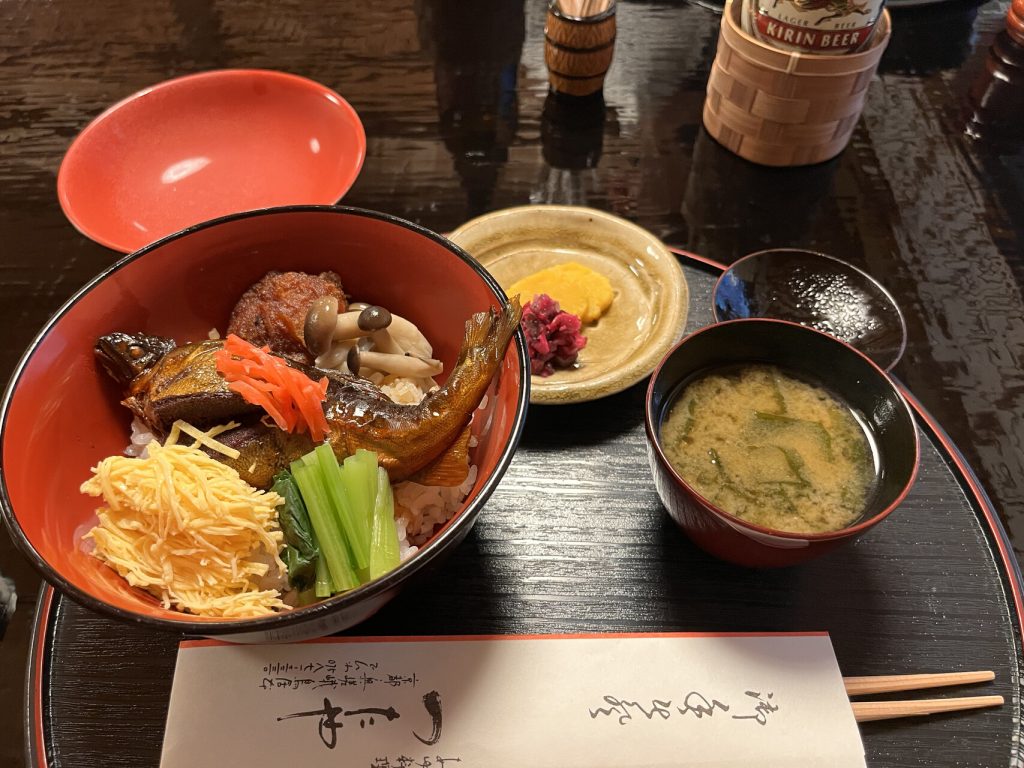
Lunch at Ayu-no-Yado Tsutaya
Ayu-no-Yado Tsutaya is a kaiseki restaurant which serves traditional set menus called teishoku. Take your shoes off, and enjoy an authentic lunch in a beautiful tatami room.
The menu normally has two options, ayudon which is sweet fish over rice or unagidon which is eel over rice. Both meals are served with miso and pickles.
This restaurant takes cash only.
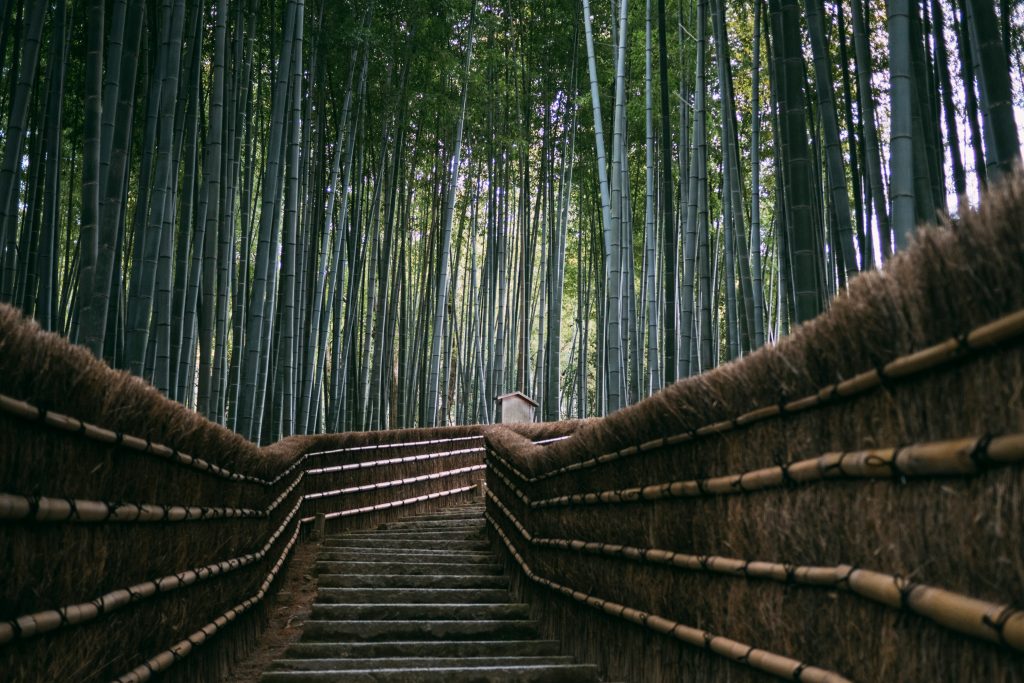
Adashino-Nembutsu-ji Temple
Adashino-Nembutsu-ji is a 9th century temple founded by the monk Kūkai. There are two reasons to visit this temple: its 8,000 Buddhist stone statues representing the souls of the deceased and the stunning bamboo forest located at the back of the temple.
Every year on August 23rd and 24th, the temple hosts the Sento Kuyo ceremony, where thousands of candles are lit to honor the spirits of the departed.
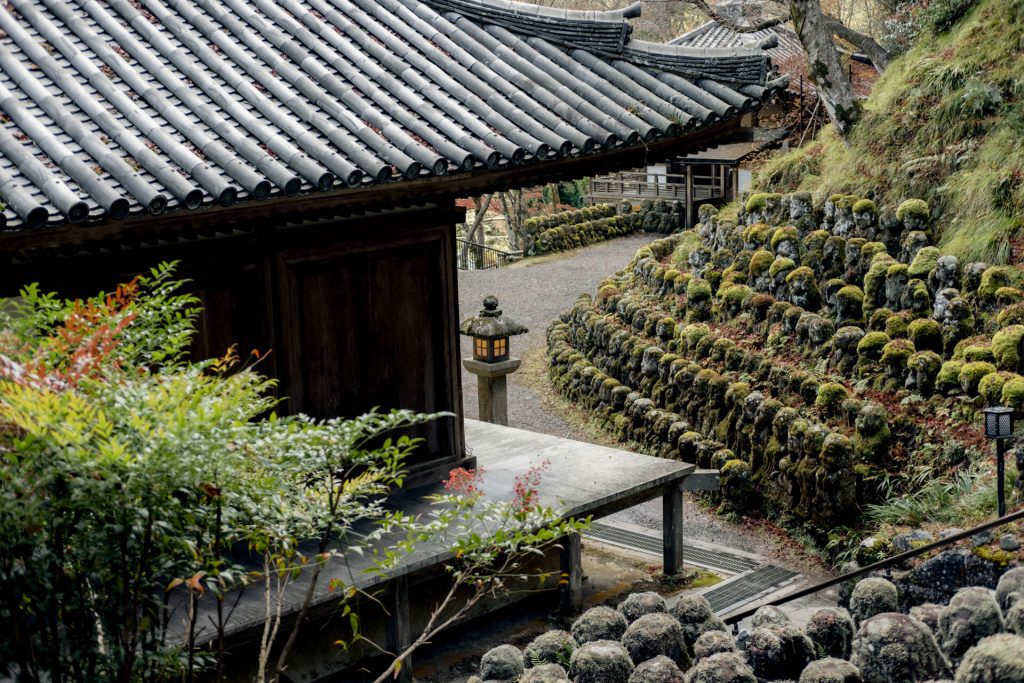
Otagi Nenbutsu-ji
After a short walk, you will reach the final attraction of the day: Otagi Nenbutsu-ji.
Otagi Nenbutsu-Ji is an 8th century secluded temple, very much off the beaten path. The temple is special because it’s home to over 1200 rakan covered in moss. A rakan is a stone statue representing the disciples of Buddha.
All rakan statues in the Otagi Nenbutsu-Ji have been donated, and a majority have been sculpted by amateurs. It’s a fairly small temple but really beautiful and truly zen.
Day 3: Downtown and Fushimi Inari
You’ll wear a Japanese kimono, learn about tea ceremony and how to make the perfect matcha, then you’ll sample lots of street food at Nishiki Market, called Kyoto’s kitchen. You’ll dive into the city’s history at Nijō Castle, followed by an afternoon at Fushimi Inari Shrine, one of Japan’s most iconic landmarks.
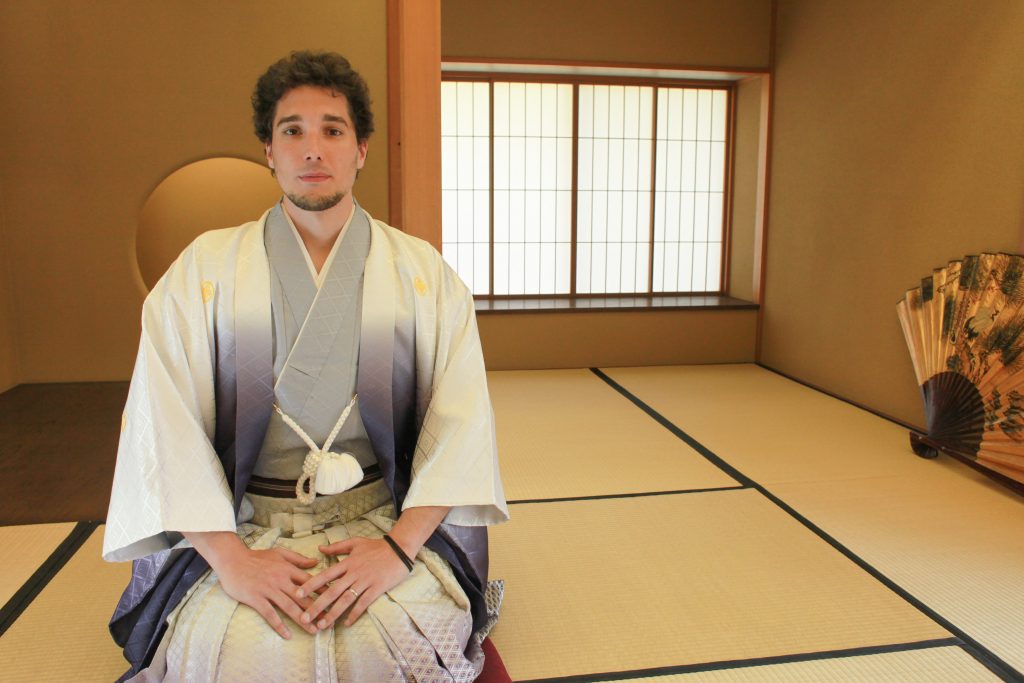
Kimono & Tea Ceremony
Begin your day with a traditional kimono experience followed by a tea ceremony. The ceremony is hosted in a designated cultural property, surrounded by breathtaking gardens worth exploring.
Your adventure kicks off with selecting and dressing in a kimono from a range of exquisite options, with staff on hand to ensure you look your best for this authentic Japanese experience. Ladies will also have the opportunity to have their hair styled to complement their kimono and traditional Japanese appearance.
You’ll have plenty of chances to take photos in your authentic kimono against the backdrop of Maikoya’s stunning Japanese gardens.
About 30 minutes later, the tea ceremony begins. You’ll actively participate in the tea ceremony, guided by a tea master.
Advance reservation is required, and you can book your kimono and tea ceremony experience via Viator.
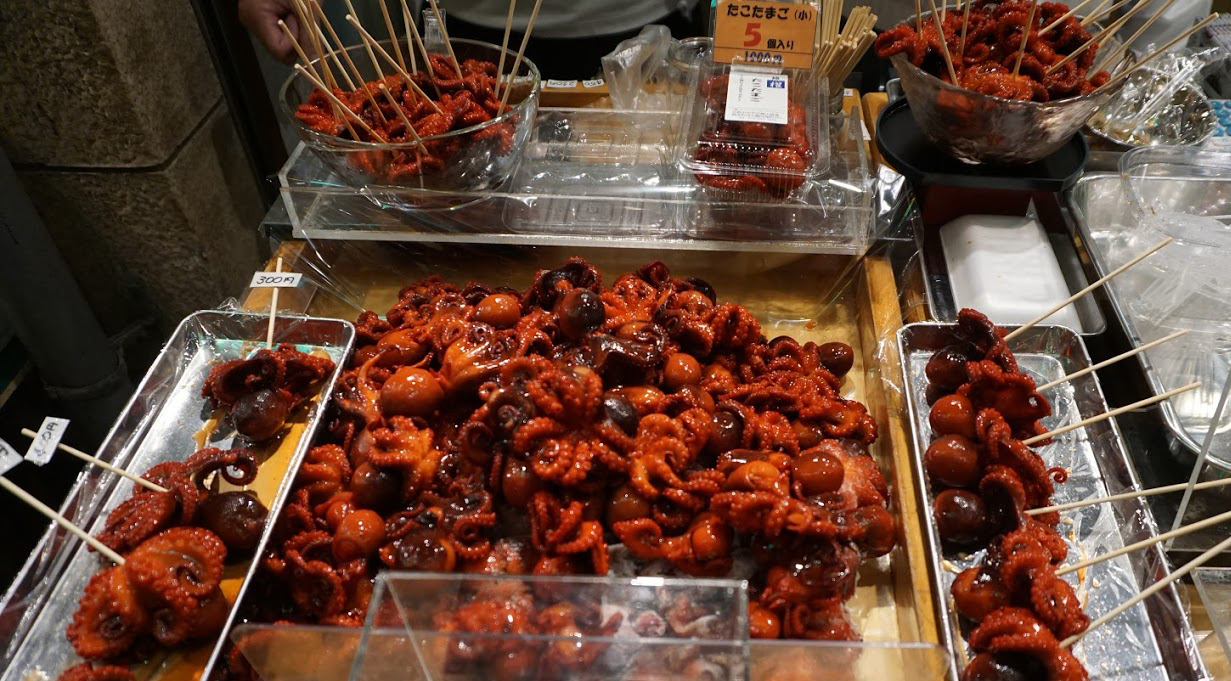
Nishiki market
Nishiki Market, also known as “Kyoto’s Kitchen” is a traditional food market that stretches over a narrow, covered pedestrian street that runs for approximately five blocks.
You will find everything from snacks, street food to retail shops and restaurants.
Recommendations to try at the market:
- Takotamago – Baby octopus on a stick with an egg in its head
- Charcoal Ice Cream – Bamboo charcoal mixed with vanilla ice cream
- Yatsuhashi – Kyoto’s cinnamon-flavored traditional sweet, shaped like a small, folded triangle and filled with sweet red bean paste (anko)
- Dango – Skewered rice cakes (like mochi) covered in a sweet, sticky soy sauce glaze
- Ōban-yaki or Imagawayaki – Japanese sweet cake filled with sweet azuki bean paste
- Warabimochi – Jellied dipped in kinako (soybean flour) and sugar.
Nijō Castle
Built in the early 17th century, Nijō Castle functioned as both a residence and administrative center for the Tokugawa shoguns. Its architecture merges samurai fortress features with the ornate style of the imperial court, resulting in the distinctive “shoin-zukuri” style.
The castle’s main areas, Ninomaru Palace and Honmaru Palace, are notable for their elaborate sliding doors (fusuma) and detailed painted screens (byōbu), illustrating themes from nature, folklore, and historical events.
A unique aspect of Nijō Castle is its “nightingale floors.” These floors, designed to emit a chirping sound akin to a nightingale’s song when stepped on, served as a clever security measure to alert occupants of anyone moving within the castle.
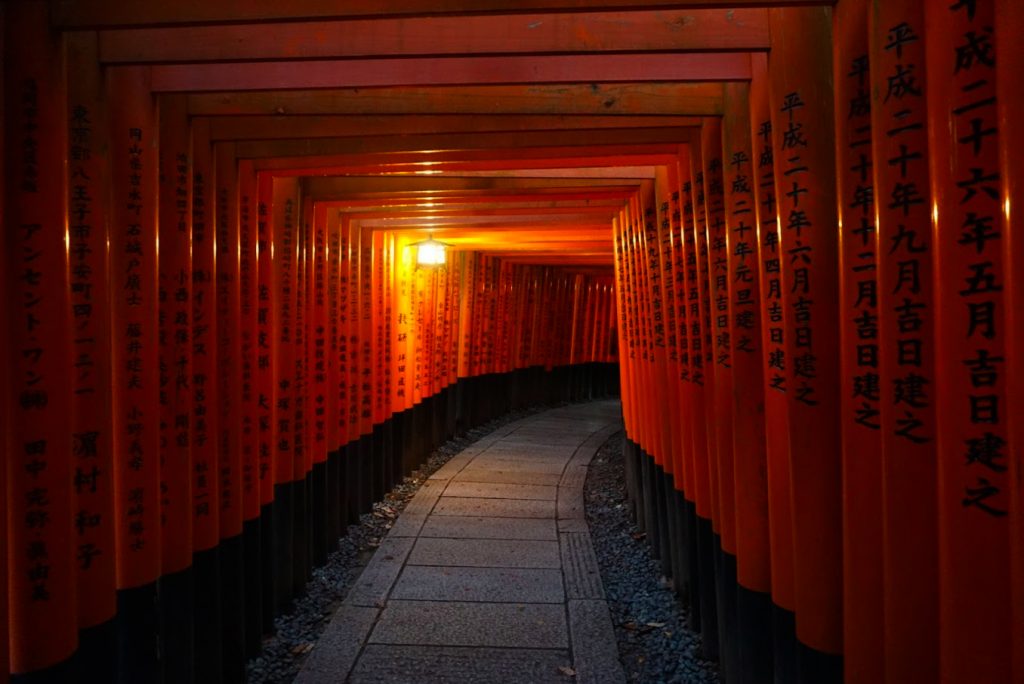
Fushimi Inari Taisha
Fushimi Inari Shrine was founded in the 8th century, and it’s considered the most important Shinto shrine in Japan dedicated to Inari. Inari is the Shinto god of rice, agriculture, and prosperity. Foxes (kitsune), believed to be Inari’s messengers, are a common motif throughout the shrine, often depicted holding keys to granaries in their mouths.
The shrine’s most famous feature is the Senbon Torii (thousands of torii gates), which line paths through the wooded forest of the sacred mountain. These torii gates, which have been generously donated by individuals and businesses in hopes of receiving blessings or expressing gratitude to Inari for their prosperity, form a visually stunning tunnel that draws visitors from all over the world.
Day 4: Philosopher Path & Kinkaku-ji
A combination of nature and temples, perfect for a meditative day in Kyoto. You’ll see the most important temples and gardens in the city, and walk the stunning Philosopher’s path, which runs along a canal full of cherry trees. My tip for today is to have plenty of cash with you, as many temples take cash only as entrance fee.
For lunch, try a boiled tofu set meal around Nanzen-ji Temple.
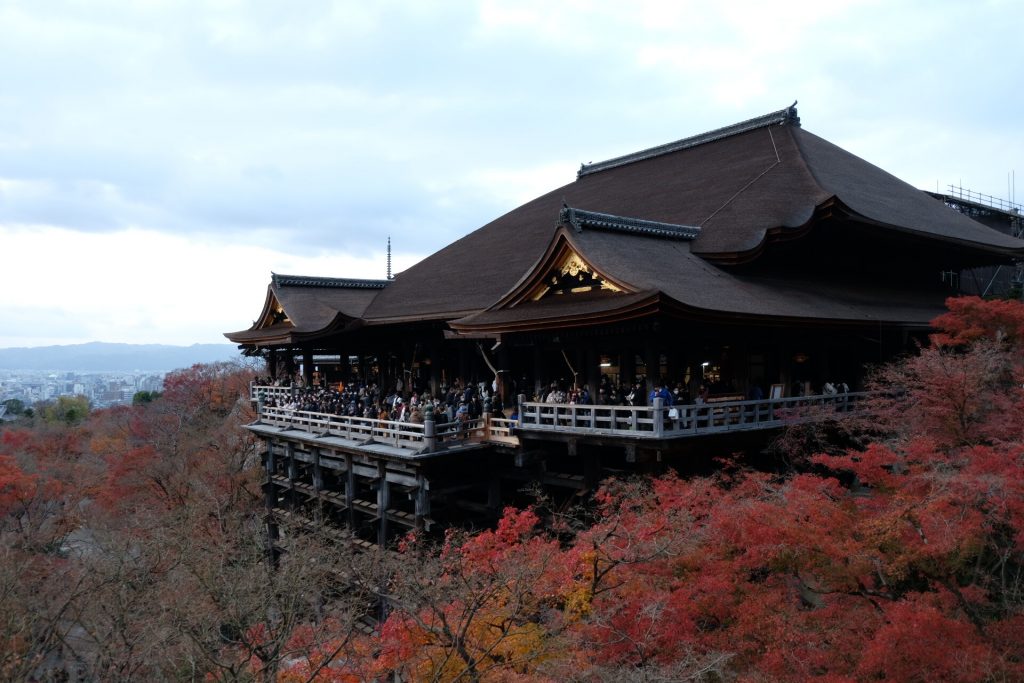
Kiyomizu-dera
Kiyomizu-dera (officially Otowa-san Kiyomizu-dera) is one of the main attractions in Kyoto, in the eastern part of the city. The temple has a history that dates back to 778, although the current buildings were constructed in 1633. It’s part of the Historic Monuments of Ancient Kyoto UNESCO World Heritage Site.
Kiyomizu-dera is famed for its large wooden stage that juts out from the main hall, offering jaw-dropping views of the cherry and maple trees below.
There’s a small waterfall within the temple grounds where visitors can drink for health, longevity, and success in studies. Each stream of the waterfall offers a different benefit, so pick wisely, as it is said that the Gods don’t appreciate it when you drink from all three.
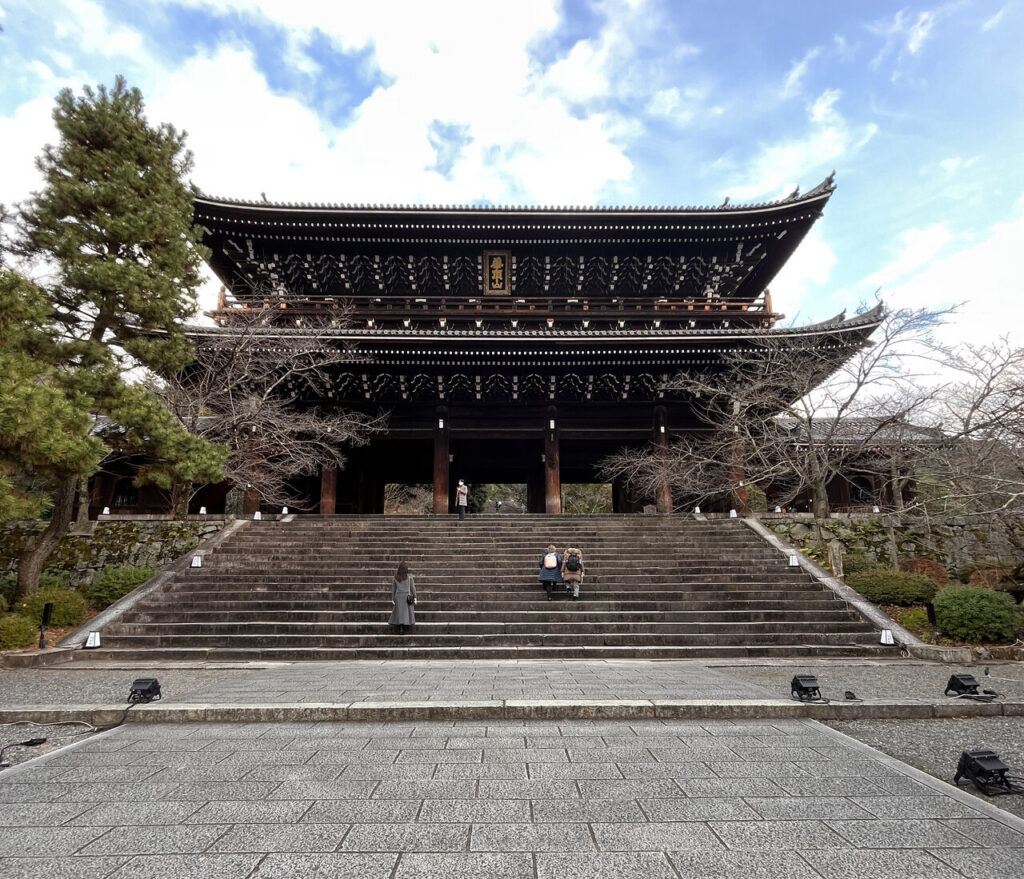
Nanzen-ji Temple
Established in the 13th century, Nanzen-ji Temple was originally a retirement villa for the emperor before being converted into a Zen temple.
One of the prominent features of Nanzen-ji Temple is the grand Sanmon gate, a designated National Treasure of Japan. It is one of the oldest and largest temple gates in the country, and visitors can climb to its top level to enjoy panoramic views of the temple grounds and the surrounding Higashiyama mountains.
Nanzen-ji Temple is also known for its large aqueduct, called the Suirokaku and part of the Lake Biwa Canal, which was constructed during the Meiji period.
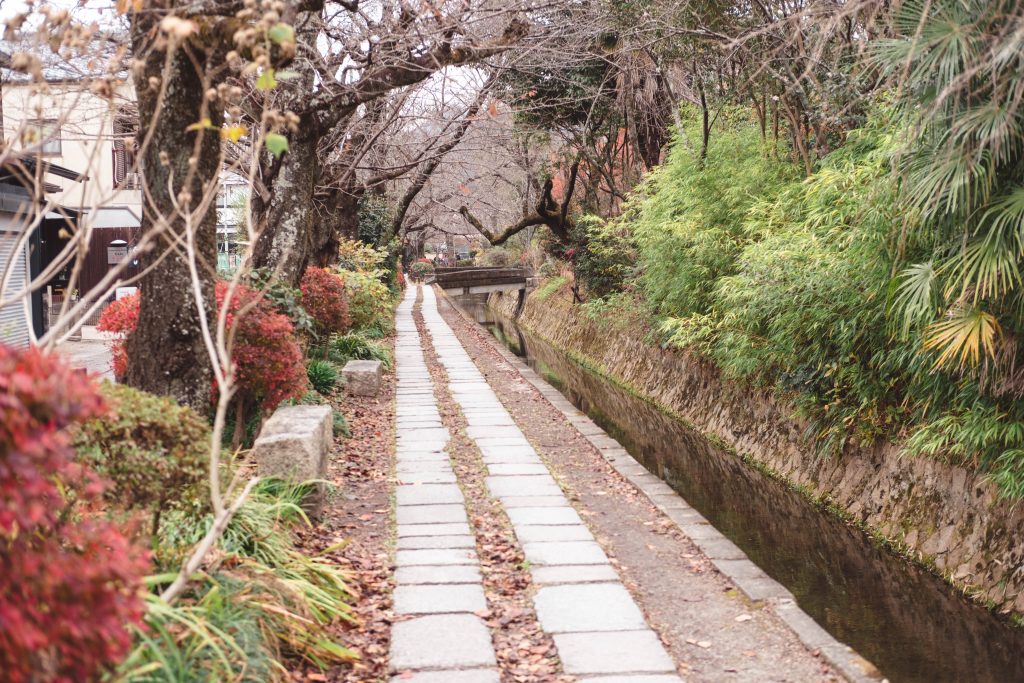
Philosopher’s Path
From Nanzen-ji Temple you will make your way to Ginkakuji, and in order to do so, you will take the famous Philosopher’s Path in Kyoto.
The Philosopher’s Path (Tetsugaku no michi) is a 2 km picturesque walkway that follows a canal lined with hundreds of cherry trees. The path got its name from Nishida Kitaro, one of Japan’s most renowned philosophers, who was said to have used the path for daily meditation while walking to Kyoto University.
The Philosopher’s Path is incredibly popular during the cherry blossom season, but it’s honestly just as beautiful in the autumn when the leaves change their color. There are small, easily missed cafés along the path that serve matcha tea and traditional sweets.
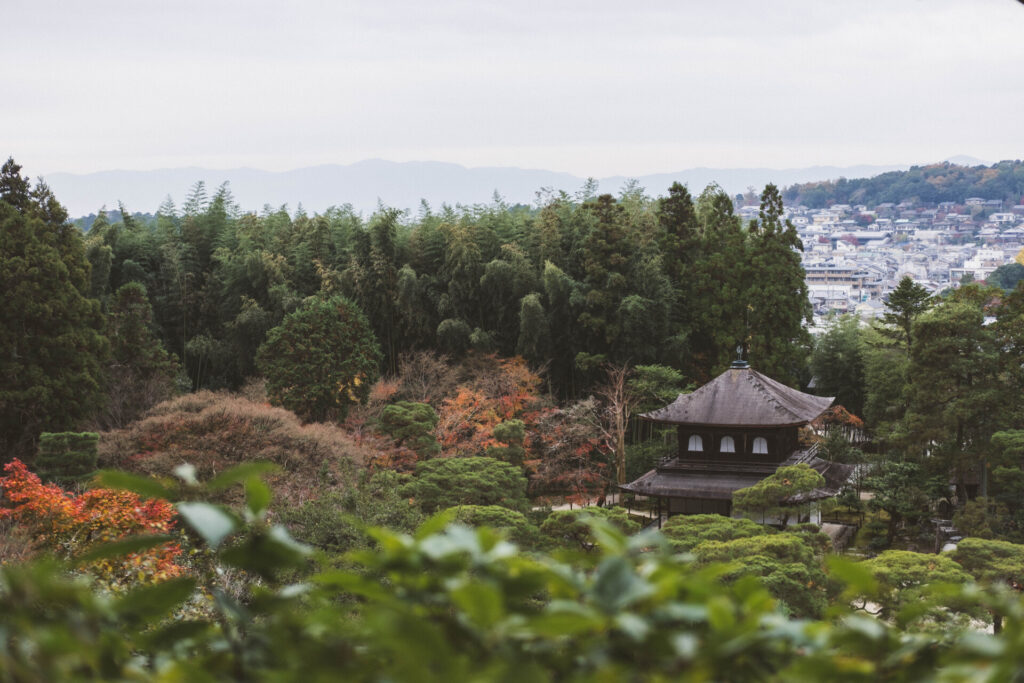
Jisho-ji (Ginkakuji)
Jisho-ji (most commonly known as Ginkaku-ji or Silver Pavilion) was constructed in the late 15th century and was intended to be a second retirement villa – after Kinkaku-ji – for the shogun Ashikaga Yoshimasa. The temple is named Silver Pavilion due to its original plan to be covered in silver foil, though the silver coating was never applied.
While the Silver Pavilion itself is a must-see, the moss garden and the dry sand garden, which features a carefully raked pattern symbolizing the sea and Mt. Fuji, are equally captivating.
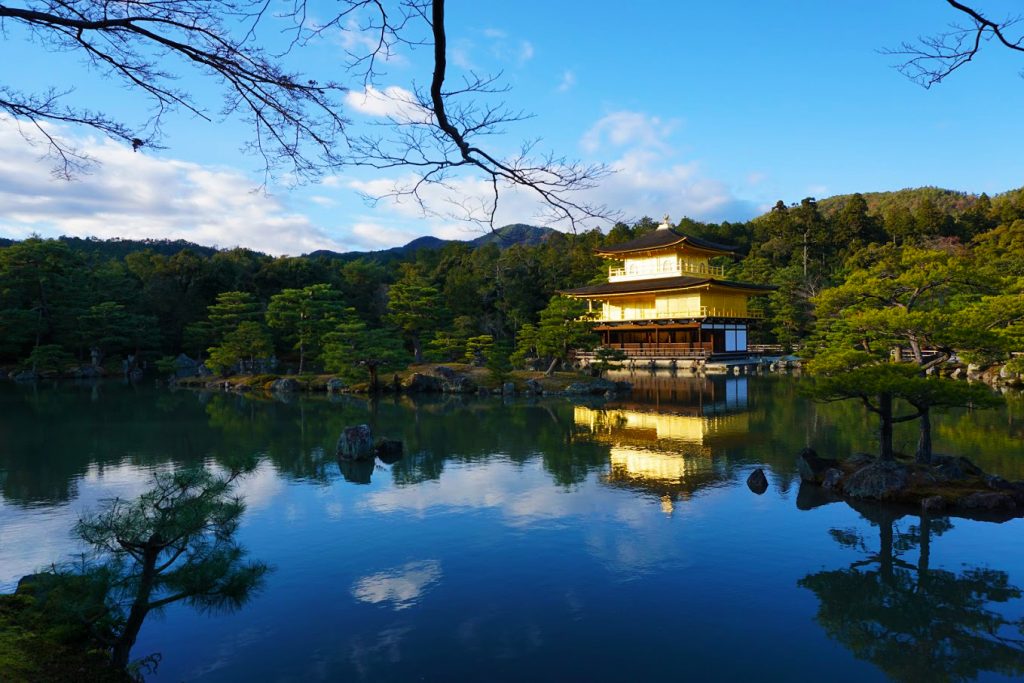
Kinkaku-ji
In the interest of saving time, I recommend taking a taxi from Jisho-ji to Kinkaku-ji which is about 20 minutes drive. The last entry at Kinkaku-ji is at 4:30pm, so you will want to time your arrival for this one!
Kinkaku-ji also known as the Golden Pavilion, was originally built in 1397 as a retirement villa for Shogun Ashikaga Yoshimitsu, and it was converted into a temple by his son after his death. The Golden Pavilion, adorned in gold leaf, looks its most exquisite when viewed from an angle that captures both the pavilion and its iconic reflection in the pond in front.
Day 5: Day trip to Nara
Nara, once the capital of the Japan from 710 to 794, is home to some of the oldest temples in the country. It’s full of attractions, including eight UNESCO World Heritage Sites, such as the Nara Palace Site, five Buddhist temples, a Shinto shrine, and an associative cultural landscape.
To get to Nara from Kyoto, take the JR Nara Line from Kyoto Station to Nara Station. The trip takes just under an hour, and it is covered by your Japan Rail Pass.
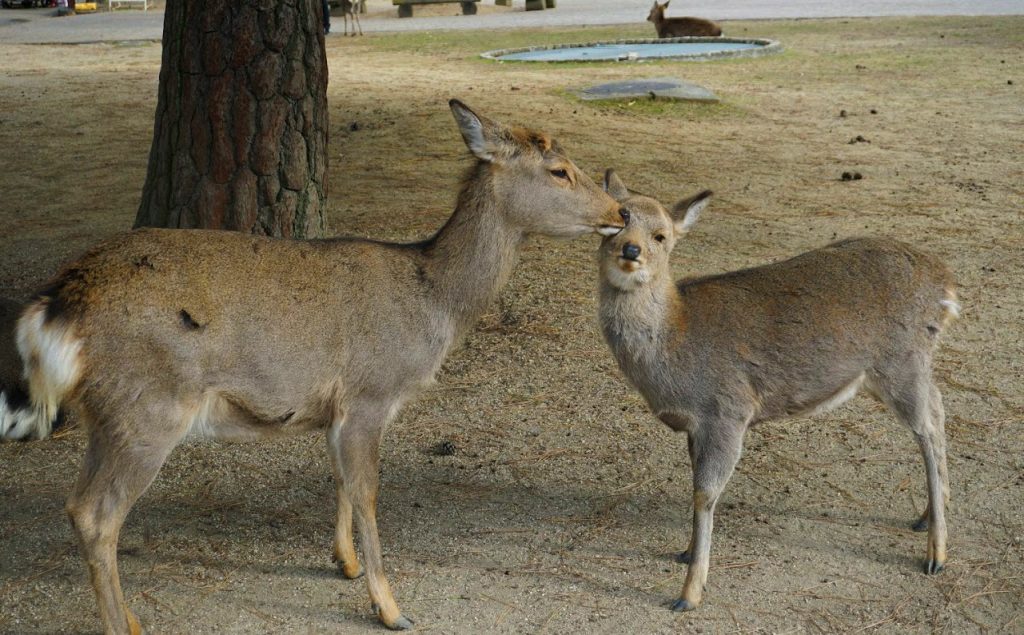
Nara Park
Nara Park, located in the city of Nara, is renowned for its free-roaming sika deer, which are considered semi-wild and revered as messengers of the Shinto gods.
You can interact closely with the deer, feeding them special crackers (shika senbei) or snapping photos alongside them.
These deer have become accustomed to human interaction, often following visitors in hopes of receiving food, and have even mastered the art of bowing to request treats. My husband and I experienced this firsthand when a few deer trailed us for over 20 minutes, eagerly awaiting more snacks.
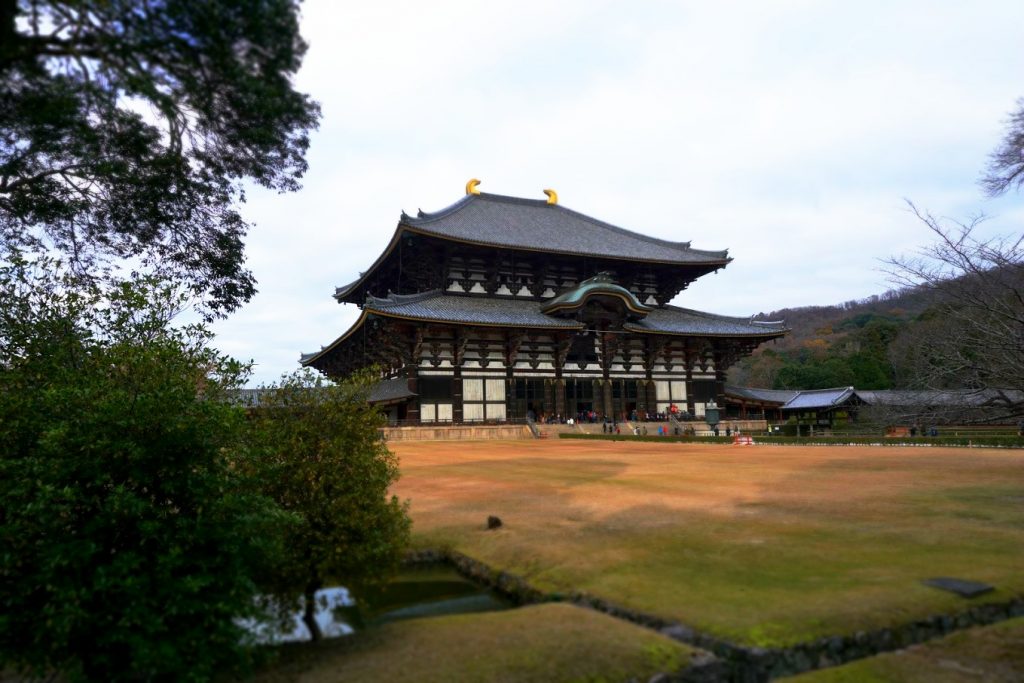
Todai-ji Temple
Todai-ji Temple houses the world’s largest bronze statue of the Buddha, known as Daibutsu (15 meters in height). Many people visit Japan specifically to see Todai-ji which is a listed UNESCO World Heritage Site as one of the “Historic Monuments of Ancient Nara”.
Todai-ji Temple dates back to the 8th century and it’s important because it marks the adoption of Buddhism as a state religion. It was constructed under emperor Shōmu, by the best craftspeople in Japan with the latest building technology.
An impressive sight is the Great South Gate (nandaimon) considered a National Treasure.
Kasuga-taisha Shrine
Kasuga-taisha Shrine, dating back to the 8th century in Nara, is famous for its many bronze and stone lanterns along the paths to the shrine. These lanterns really stand out during the Lantern Festivals in February and August, when they’re all lit up, creating a magical atmosphere.
The shrine sits in the middle of Nara’s ancient forest. You can check out the main part of the shrine for free, but there’s an area you can enter for a fee. Paying to enter this part lets you get a closer look at the shrine’s detailed architecture and some of the quieter, more private spots.
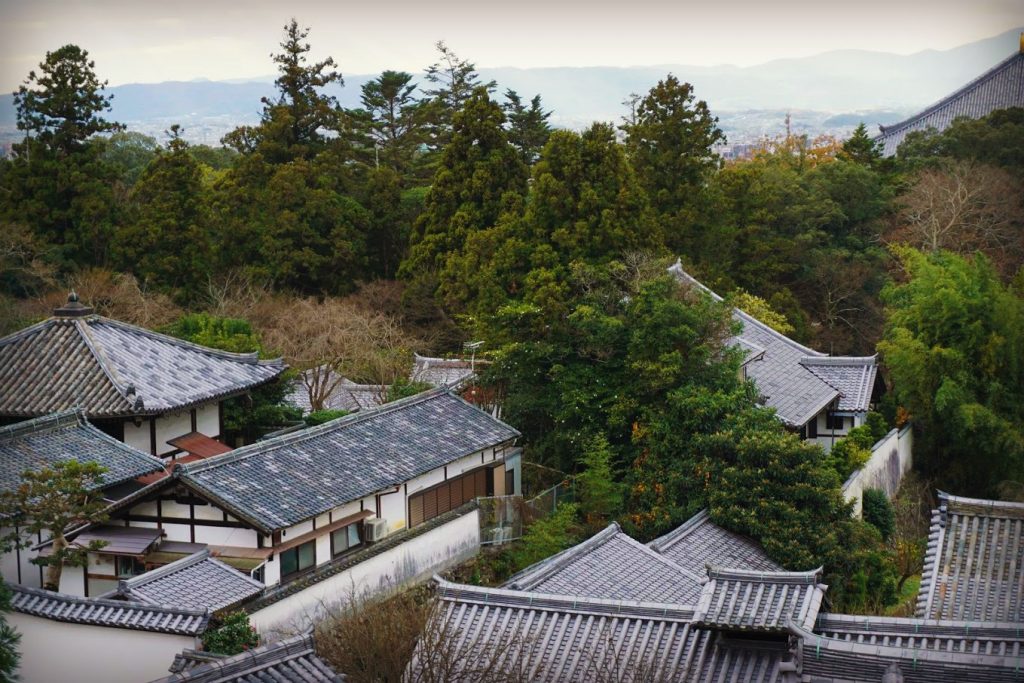
Naramachi
Naramachi is the old merchant district, lined with traditional machiya houses (long, narrow wooden townhouses). These buildings, recognizable by their wooden lattice work and tiled roofs, have been transformed into shops and eateries, many retaining their original charm.
Put Naramachi Koshino Ie on your list of places to visit. Managed by the local government, it’s a publicly accessible replica of a traditional machiya house.
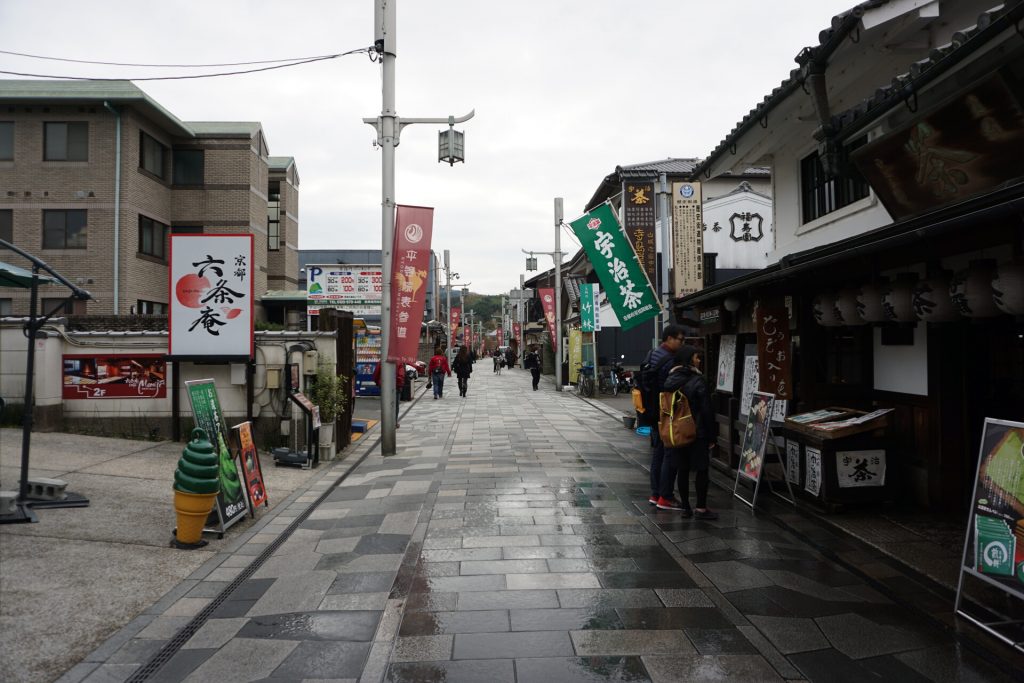
Uji
Uji is a small-town en route to Kyoto from Nara. From Nara Station take the Nara Line to Uji Station. The ride takes 30 minutes.
Synonymous with Japan’s original site for tea cultivation, Uji became famous for its superior quality green tea. The city has the oldest tea shop in Japan, dating back to 1160.
Uji is very small, which means it can be easily explored on foot. From the train station you will make your way to Omotesando which is the town’s main shopping street. It’s a great location to buy souvenirs and snacks, as well as ceremonial grade matcha tea.
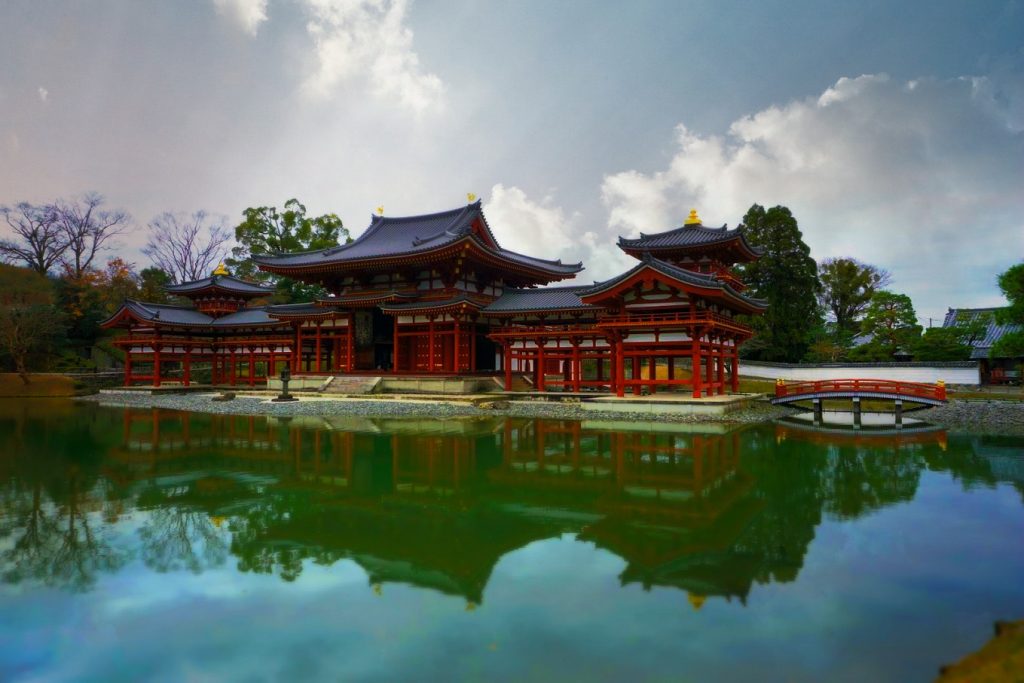
Just a short walking distance away is the Byōdō-in Temple, an 11th century UNESCO World Heritage Site famous for its Phoenix Hall (Hōō-dō). The Phoenix Hall is depicted on the Japanese ten-yen coin, and a phoenix figure from the temple is featured on the back of the ten-thousand-yen note.
Accommodation in Kyoto
Gion tends to be the preferred accommodation area in Kyoto. I curated the top three best hotels in Kyoto for first timers. If you wish to stay in a ryokan, note that most of them book months in advance. Check my comprehensive guide on where to stay in Kyoto for more options.
The Hotel Seiryu Kyoto Kiyomizu is a member of the Leading Hotels of the World and a fantastic luxury option for those who want to stay in Higashiyama, super close to most of the top attractions. It’s a great hotel and very easily accessabile for this particular 5 day Kyoto itinerary.
Good nature hotel is just 400 meters from the Gion Shijo Station, and it’s a luxury hotel for a mid-range price point. I’ve selected this hotel because of its ideal location, which makes all points of interest in this itinerary easy to get to from the accommodation.
Hotel Rakurakuan is affordable, clean and well located within walking distance from public transport. While points of interest can only be reached via public transport, the hotel is just a 20-minute walk from the main Kyoto station, making it still perfectly convenient for your stay in Kyoto.
More tips for Kyoto
I believe five days in Kyoto is ideal, but I understand many first-time visitors to Japan can only spare two days within their week-long trip. That’s why I’ve created a 2-day Kyoto itinerary to assist you.
Having spent considerable time exploring and returning to Kyoto, I’m eager to share more insights through my articles to enhance your experience. Be sure to also look at my Kyoto travel guide for further tips. And if you’re considering exploring beyond, our Japan Guide offers a full and detailed overview of other areas.
- Kikunoi Honten in Kyoto Review
- Best time to visit Kyoto: Month by month break down
- Kyoto vs Osaka: Which is better?
- Ultimate Kyoto 2 day Itinerary for first-timers 2024
- 50 best things to do in Kyoto, Japan
- Sakura Japan: Mount Yoshinoyama
- Best day trips from Kyoto
Frequently Asked Questions
How many days do I need in Kyoto?
To fully appreciate the beauty and cultural richness of Kyoto, 5 days in Kyoto is the perfect number of days. This timeframe allows you to explore the main attractions like the Arashiyama Bamboo Forest, the district of Gion, see the top temples and visit Fushimi Inari Shrine. You can even take a day trip to Nara to see the friendly sika deer at Nara Park.
Is 3 nights enough for Kyoto?
As someone who has visited Kyoto extensively, I would say that 3 nights in Kyoto can provide a decent introduction to the city, but it may feel a bit rushed to fully explore and appreciate its many attractions. While it’s possible to cover the highlights in this timeframe, extending your stay to 4 or more nights would allow for a more relaxed and immersive experience.
With 3 nights in Kyoto, you can visit the iconic landmarks such as Kinkaku-ji (Golden Pavilion), Arashiyama Bamboo Grove, and Fushimi Inari Taisha. You’ll have time to explore the historic district of Higashiyama, stroll through the traditional streets of Ninenzaka and Sannenzaka, and perhaps catch a glimpse of geisha in the Gion district.
Is 5 days in Kyoto too much?
5 days in Kyoto is the perfect amount of time to stay in the city. You’ll see the top attractions, the most important temples and even get to take a day trip to Nara.
Is Kyoto or Osaka better?
Kyoto offers a deep dive into Japan’s history, culture, and serenity, while Osaka buzzes with energy, modernity, and a celebrated food scene. Accommodations in Osaka are generally more affordable than Kyoto, with hotels comparable to Tokyo’s in terms of modernity. Conversely, Kyoto’s lodging options often provide a more traditional, authentic experience. Despite receiving fewer visitors overall, Osaka’s Dotonburi rivals Kyoto’s Higashiyama in terms of crowd size during peak seasons. As someone visiting for the first time, my preference leans towards Kyoto for its authentic snapshot of traditional Japan. However, for a detailed comparison, check out my full guide on Osaka vs. Kyoto.
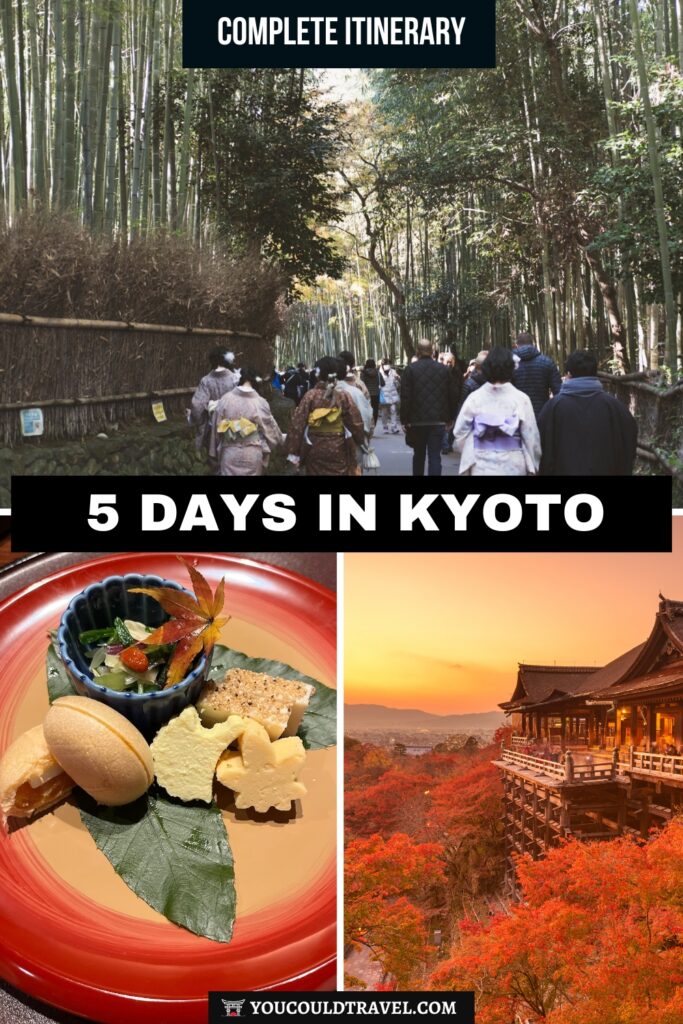
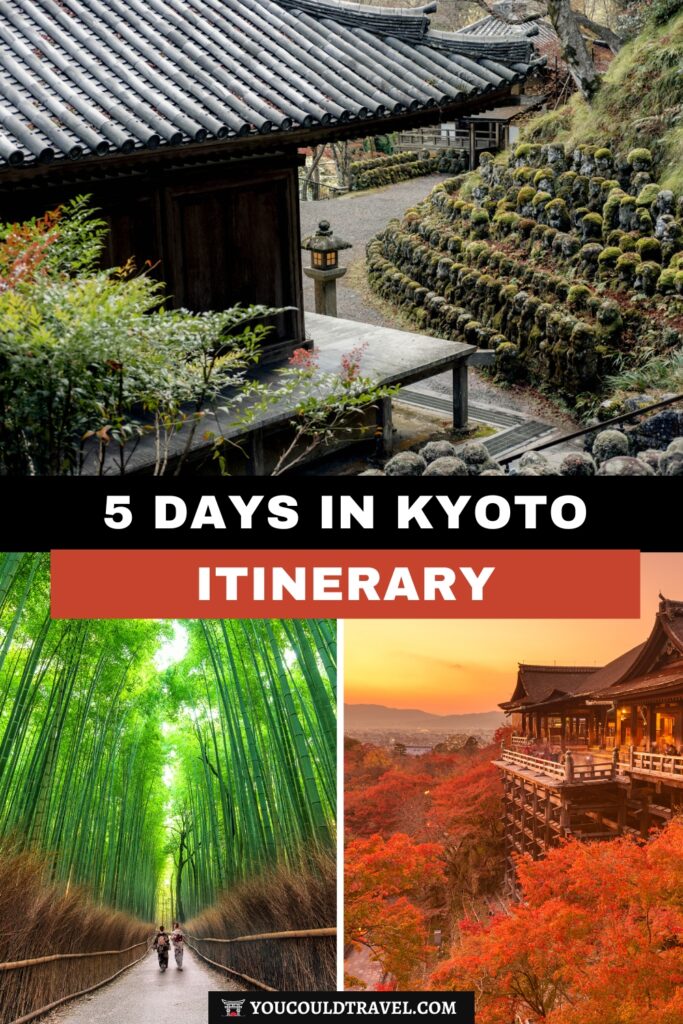

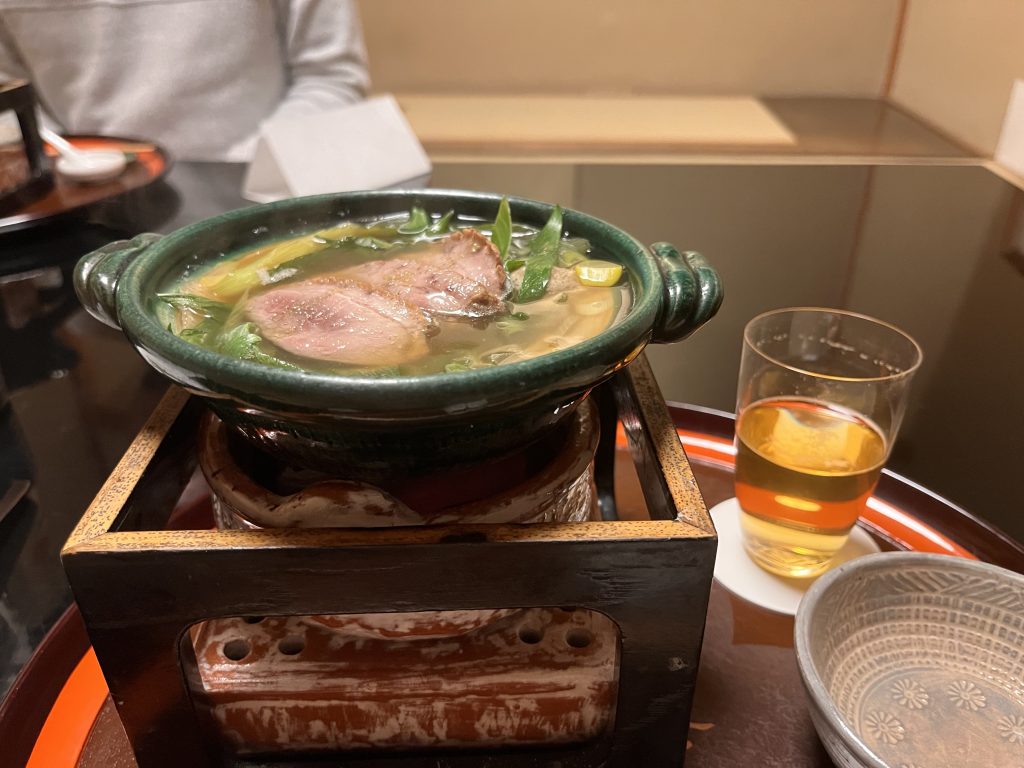
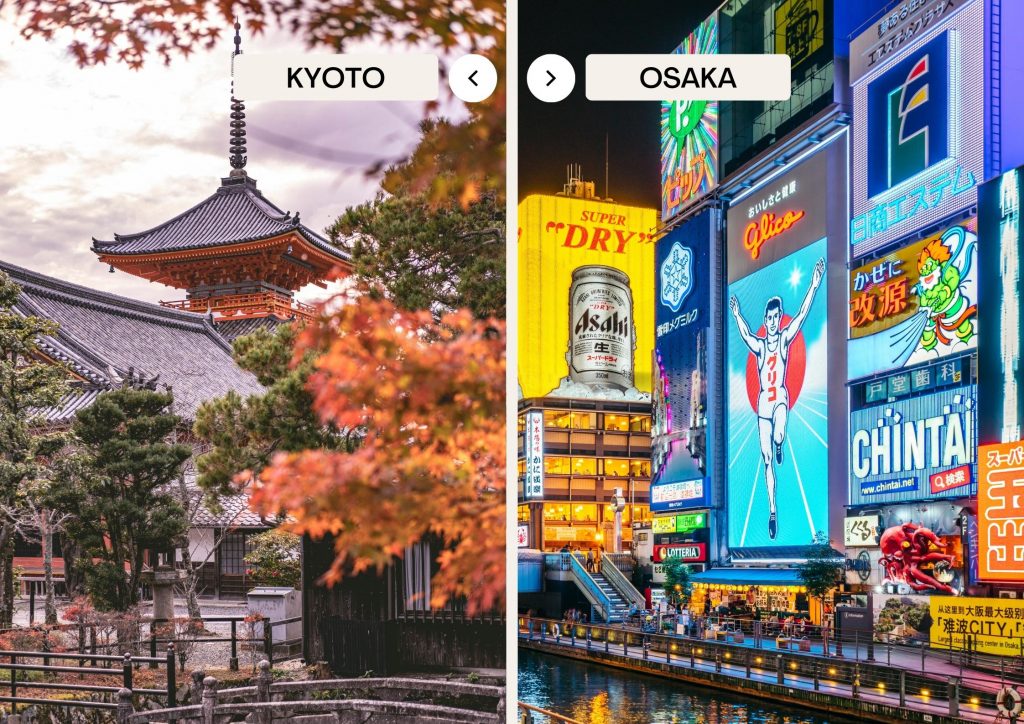
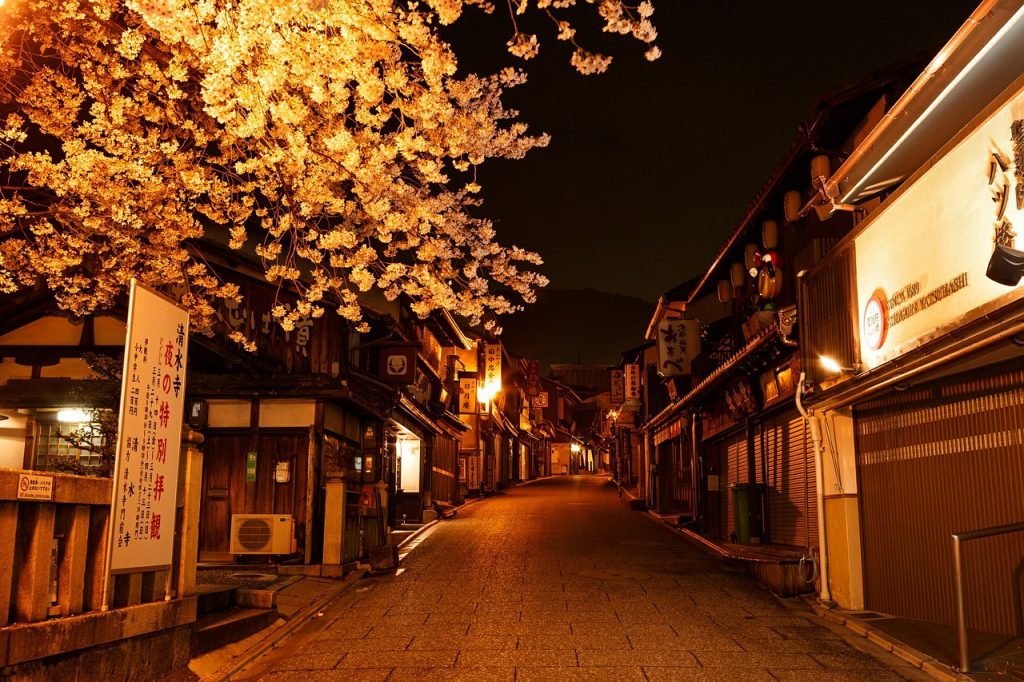
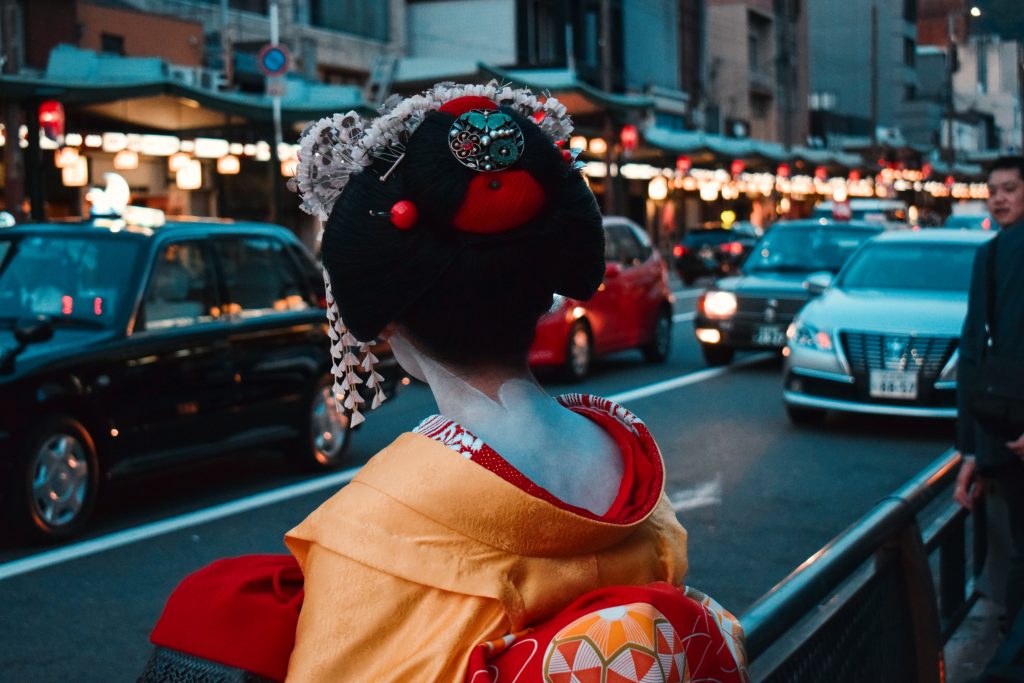
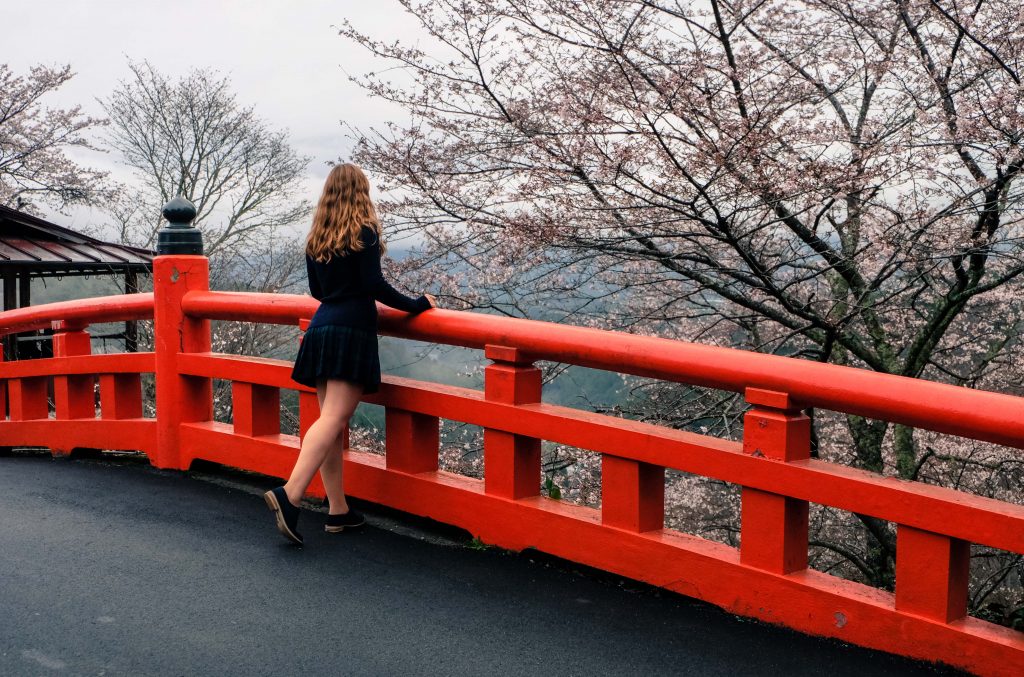


Leave a Reply